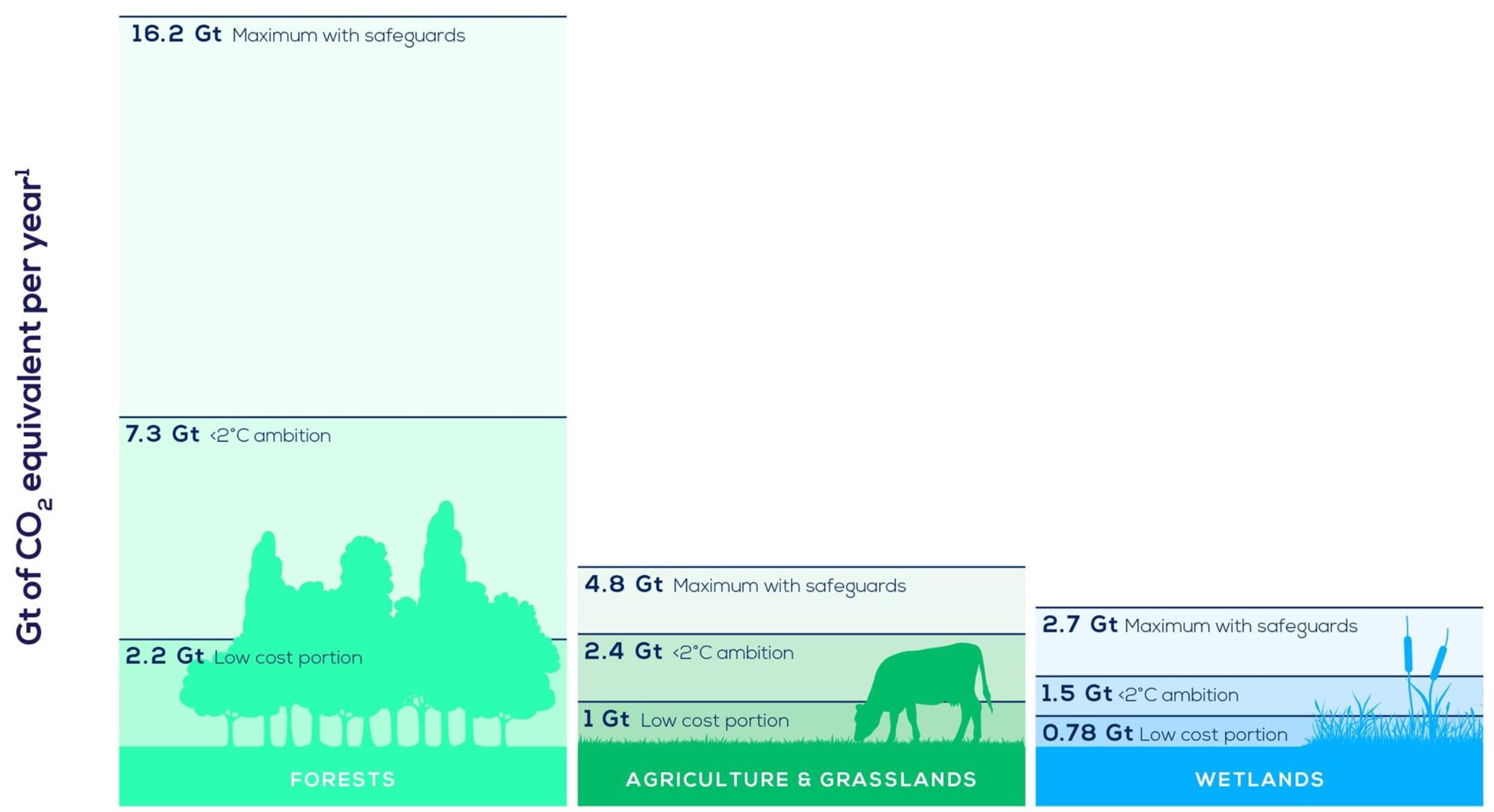Reducing wildfires and water risks with nature-based solutions

Nature-based solutions are being provided to reduce water risks.
Image: kazuend/Unsplash
Stay up to date:
Fresh Water
- Nature-based solutions are used for the protection, management and restoration of natural systems (such as trees and forests, wetlands and grasslands).
- These kinds of solutions can protect businesses from major water supply disruptions in ways that conventional corporate water stewardship cannot, the World Resources Institute (WRI) warns.
- Healthy forests can improve the quality of water, regulate the supply of water, and lower potential costs for artificial treatment, such as filtration systems.
- Companies need to step up collectively and invest in the protection of resources to ensure water security, says the WRI.
Companies depend fundamentally on clean, timely and plentiful water.
They use it to manufacture products, irrigate crops and cool industrial processes that generate heat. Water shortages can create huge business risks. California, for example, recently restricted water use for 6 million residents and businesses due to unprecedented drought. Meanwhile, demand for water in this region is projected to grow even as climate change shrinks the overall water supply.
Corporations have responded to these growing risks by measuring their water use, setting stewardship targets and implementing site-level strategies to improve water quality and supply. They’ve learned how to produce goods and services while consuming less water by fixing leaking pipes, improving manufacturing efficiency, recycling wastewater and installing low-flow toilets.
But there’s one promising intervention many businesses are leaving on the table — investing in nature-based solutions.
How Can Nature-based Solutions Improve Water Security?
Nature-based solutions are the protection, management and restoration of natural systems (such as trees and forests, wetlands and grasslands) to address societal challenges. Rather than focusing on water solutions at the site level — such as fixing leaky pipes — nature-based solutions focus on the systems that underpin water security.
For example, restoring wetlands and other ecosystems can recharge groundwater levels and mitigate flood risk. Healthy forests can filter water, reduce water treatment costs, and regulate how quickly water is released downstream. Restoring degraded ecosystems can reduce the risk of wildfire by thinning overly dense forests, removing invasive species, and restoring the water-retaining qualities of meadows and riparian ecosystems.
These kinds of solutions can protect businesses from major water supply disruptions in ways that conventional corporate water stewardship cannot. Reducing your water footprint by 20% — while commendable and even necessary — won’t insulate your business from major water supply disruptions caused by droughts or wildfires. A single flood or wildfire could wipe millions from a company’s balance sheet in hours, such as when 2020 wildfires damaged dozens of vineyards and facilities in Northern California, costing the state’s industry an estimated $3.7 billion.
What Is Holding Back Investment in Nature-based Solutions?
And yet while a handful of companies have pioneered investing in nature-based solutions for water security, large-scale nature-based projects simply aren’t getting the investment they need.
For example, the U.S. Forest Service estimates that 63 million acres of national forests and grasslands (many of which exist upstream from corporate facilities) are at high or very high risk of wildfire, and 80 million acres require restoration. These forestlands are the source of approximately 50% of U.S. water supplies, but due to funding and other constraints, just a fraction of high-risk land is restored each year. At the current pace, it will take decades to address the growing restoration backlog, all while catastrophic fires continue to cost companies and communities billions of dollars. Why hasn’t investment in nature-based solutions caught up?
One reason is the lack of incentives for companies. Corporate goals, reporting and sustainability rating structures typically prioritize simple, near-term, quantifiable project outputs that fit neatly into annual reporting timelines and stated goals. That’s why many companies seek to fund and report on projects that offer quick implementation timelines, with outcomes generated as soon as a single year. Implementing nature-based solutions over a meaningful scale can require years of planning, permitting, stakeholder engagement and fundraising — in addition to multi-year implementation and construction windows.
What is the World Economic Forum doing on natural climate solutions?
A second reason is that the pipeline of investment-ready nature-based projects is severely under-developed. Even if an ambitious company wanted to invest extensively in nature-based solutions, it would struggle to find projects with robust and vetted designs, impact evaluations, clear permitting and funding timelines, and monitoring and evaluation systems. This is a critical bottleneck for nature-based solutions that presents an opportunity for corporate investment and innovation.
Finally, the environmental and scientific communities have not always given companies clear signals about whether and how to invest in nature-based projects. Some of this is rooted in disagreements about forest and land-based carbon credits. The inherent complexity of natural systems isn’t easily distilled to a simple calculation of acres restored to quantifiable, desired outcomes. And there are varying perspectives on how to choose priority locations, select the most effective approaches, define claims and measure progress.
3 Ways to Unlock Corporate Investment in Nature-based Solutions
In order to break through these barriers and unlock more corporate investment in nature-based solutions, we need key changes. (For the purposes of this article, we focus primarily on companies operating in the United States, though these solutions could be more broadly applicable.)
1) Ambitious, long-term corporate partnerships
First, companies should continue to step up as water leaders and create pathways for nature-based projects on a larger scale and with a longer-term horizon than conventional corporate sustainability initiatives. This means continuing to invest in projects “outside the fence line” — looking beyond narrow, near-term project outcomes to address underlying source watershed issues that undermine regional water resilience.
Corporations could work in partnership with project developers, communities and governments to co-develop large-scale nature-based projects, rather than simply plugging investment dollars into the final stages of fully developed initiatives. By being more entrepreneurial and investing in nature, a few leading companies can create the paths that other companies, investors and funders can follow. Reporting and sustainability rating systems will need to be revised to provide incentives and value to companies that step up and lead this entrepreneurial, early action.
Some companies are already making these kinds of investments at the watershed scale. Procter & Gamble funded work to reduce the risk of catastrophic wildfires by restoring land across an initial 200 acres in the Crystal Basin Recreation Area of California’s Eldorado National Forest. The project will also increase water supply to the American River watershed. If this project can demonstrate early success, it will provide momentum for more partnerships and watershed resilience projects across the entire 100,000-acre landscape located just north of last year’s Caldor Fire, including a $1.2 million commitment from the Sierra Nevada Conservancy.

Meta and Intel funded a project to help restore Rito Peñas Negras, a stream in the Santa Fe National Forest in New Mexico. Beaver dam analogs, artificial logjams designed to mimic the hydrological and ecological function of a beaver dam, will be installed throughout the stream. These structures help spread water flow onto adjacent meadows to create wetlands and increase groundwater recharge.
Google has also provided crucial support for prescribed fires on 54,750 acres in the Francis Marion National Forest in South Carolina. This project, along with conservation easement protection, aims to reduce loss of water through evapotranspiration, thereby increasing water supply, enhancing wetland functions and water quality, and increasing infiltration for groundwater.
2) A robust pipeline of nature-based projects to fund
A variety of actors need to increase the number of nature-based projects ready to receive funding from corporations.
Project developers — those that design and implement nature-based solutions, often local NGOs, community enterprises or businesses — need support from governments, scientists and civil society in project preparation. This includes assistance with planning, project design and management, and research and development.
Governments can help by tweaking policies to responsibly streamline permitting and provide more funding for nature-based solutions. Programs such as the U.S. Endowments Healthy Watersheds Consortium Grant Program and Innovative Finance for National Forests Grant Program help fund nature-based water projects and could provide a template to scale government support.
The environmental and scientific communities can do more to provide project developers with the tools and resources they need to advance their projects to maturity. Cities4Forests, a WRI-led initiative with more than 80 member cities, helps identify promising nature-based projects and provide technical support to prepare them for investment. Cities4Forests has run project preparation “accelerators” around the world, including in Brazil and India.
3) Collective action
Finally, all these actors should embrace a “collective action” approach by developing long-term partnerships to achieve a common set of goals.
For example, Danone North America’s Silk brand led corporate support of a large forest restoration project to reduce fire risk and increase streamflow across 48,000 acres of California’s Tahoe National Forest, using the Yuba II Forest Resilience Bond. In this project, project developers work with state agencies and water and electric utilities (such as Yuba Water and the State of California) to reduce wildfire risk and increase water yields across public lands upstream from corporate facilities and ingredient-growing regions. Target, Hunter Industries and the Caterpillar Foundation also provided financial support. This collective action approach allows for larger-scale impact and reduces the costs to any one entity while still providing the full suite of desired benefits.
What Will the Next Investment Look Like?
As the impacts from climate change, aridification and overconsumption of water play out daily, it’s increasingly clear that businesses must transition from transactional actions of isolated impact to transformational strategies of collective impact. Companies have untapped potential to bring about large-scale systems changes that also benefit their own bottom lines.
It’s time for companies to invest in nature-based solutions for water security.
Accept our marketing cookies to access this content.
These cookies are currently disabled in your browser.
Don't miss any update on this topic
Create a free account and access your personalized content collection with our latest publications and analyses.
License and Republishing
World Economic Forum articles may be republished in accordance with the Creative Commons Attribution-NonCommercial-NoDerivatives 4.0 International Public License, and in accordance with our Terms of Use.
The views expressed in this article are those of the author alone and not the World Economic Forum.
Related topics:
Forum Stories newsletter
Bringing you weekly curated insights and analysis on the global issues that matter.
More on Nature and BiodiversitySee all
Tom Crowfoot
May 27, 2025
Zoe Balmforth and Tim Duehrkoop
May 22, 2025
Jack Hurd and Florian Vernaz
May 21, 2025
Madeleine North
May 20, 2025










